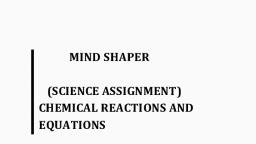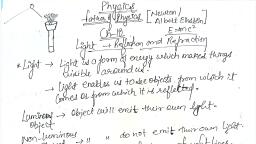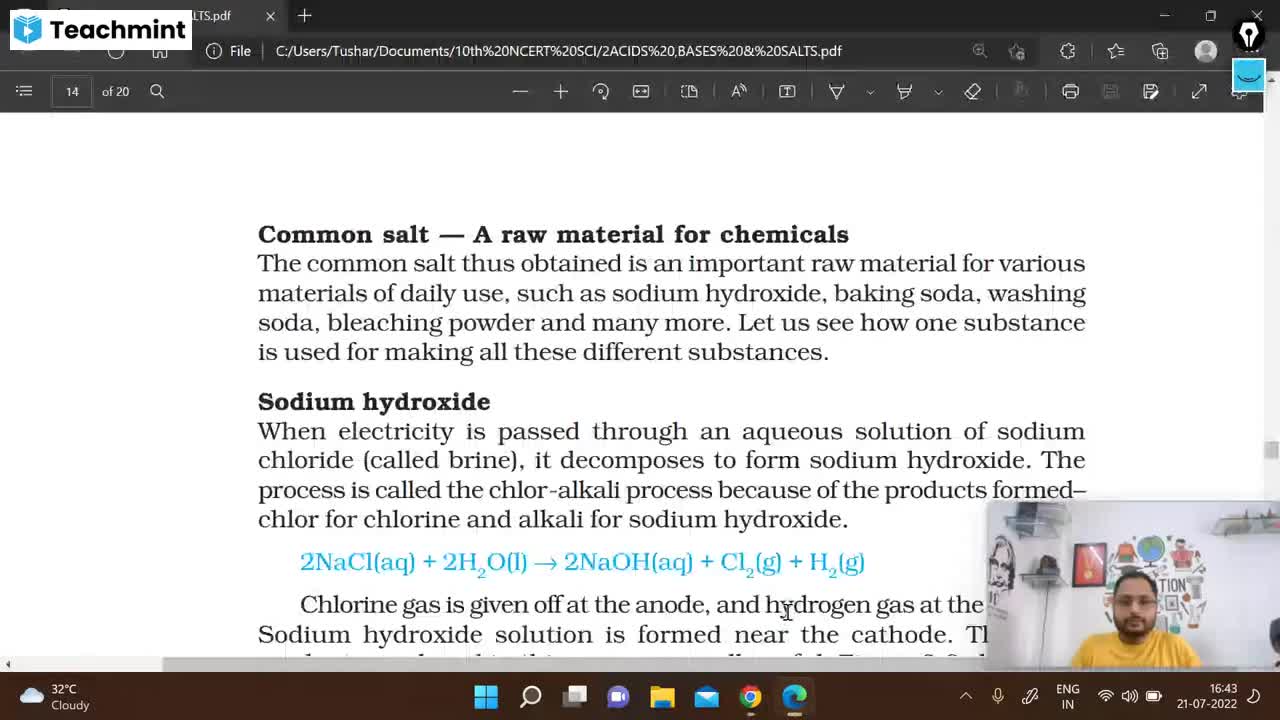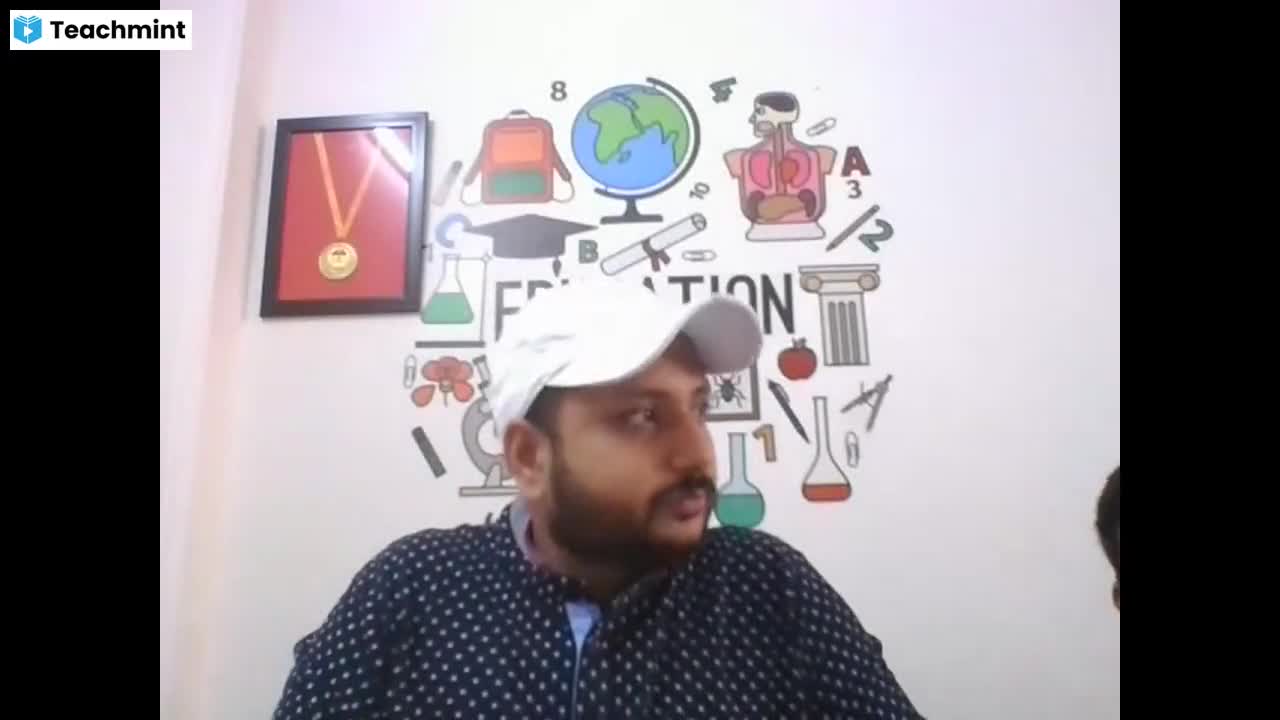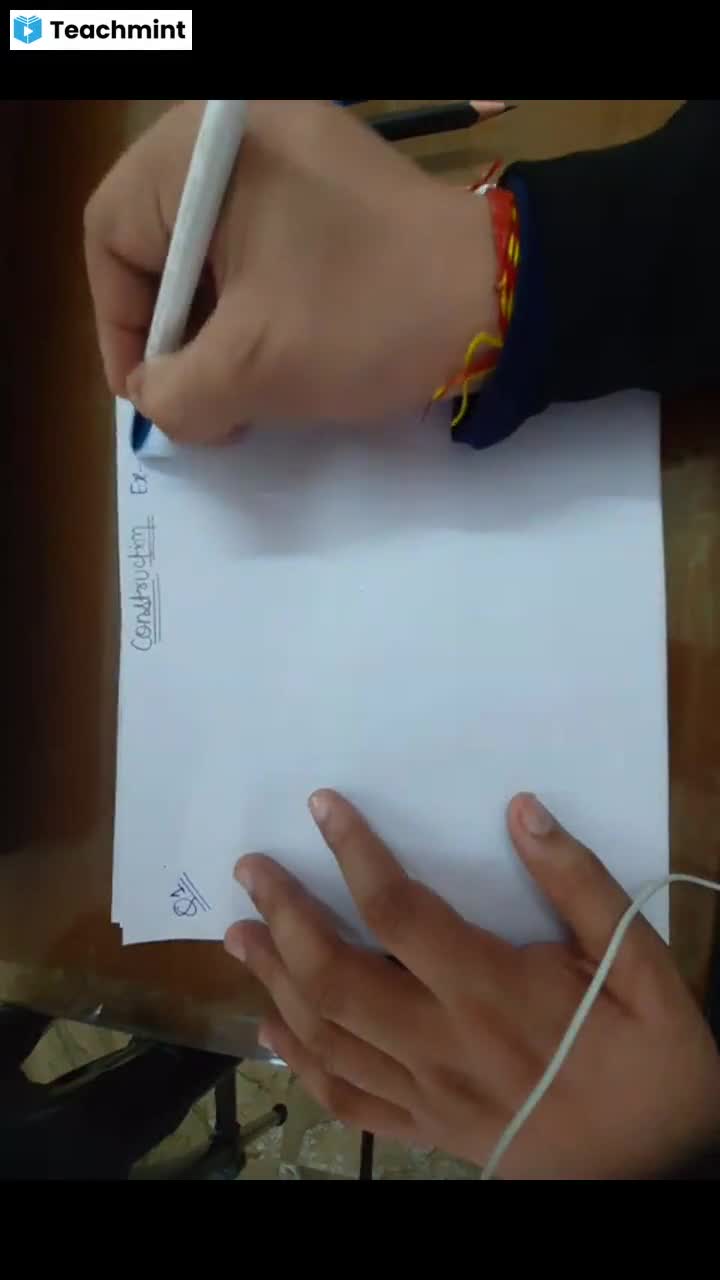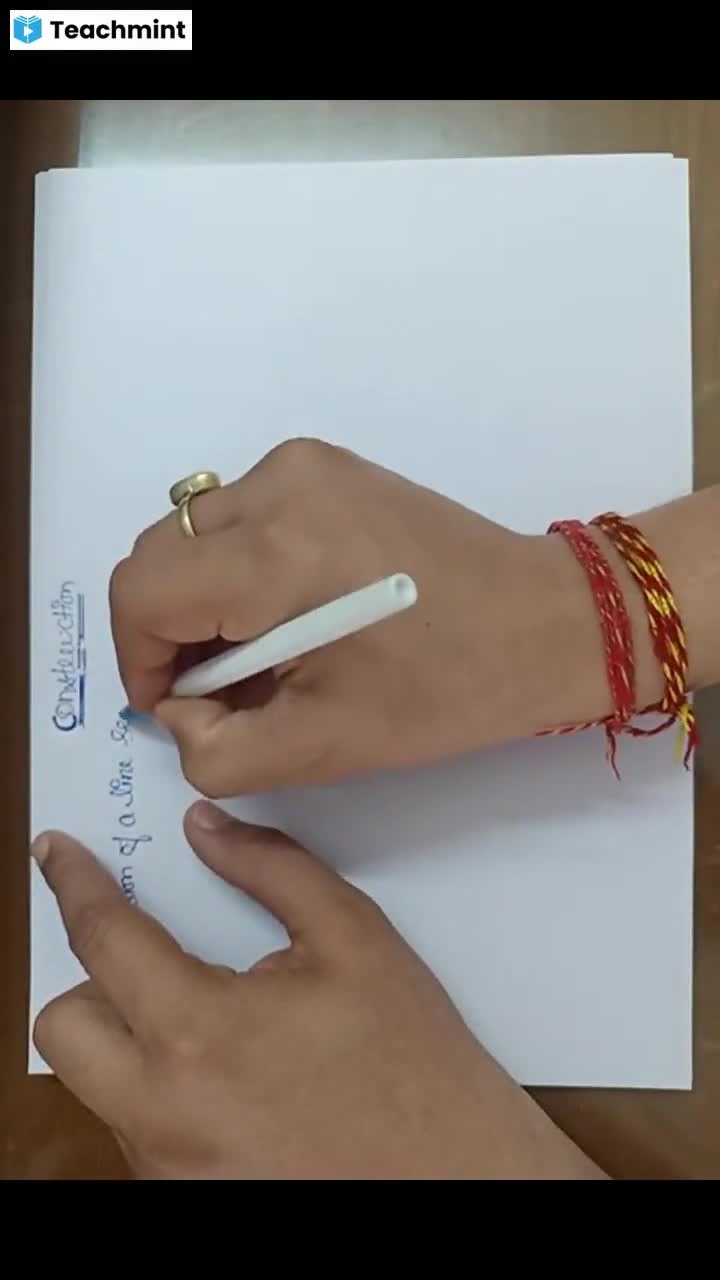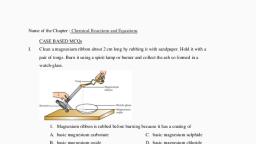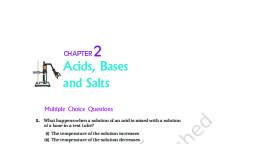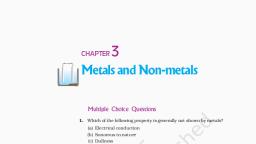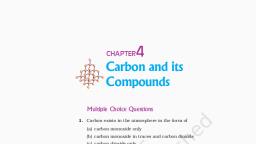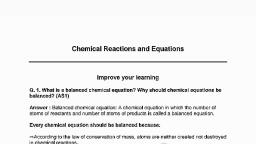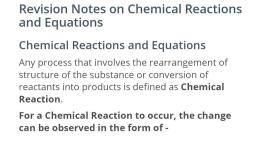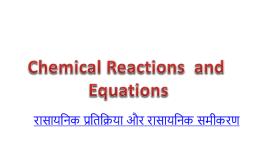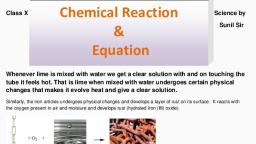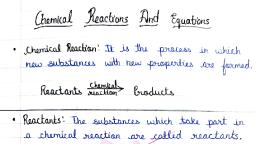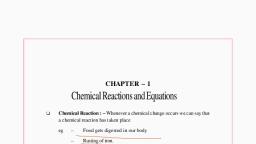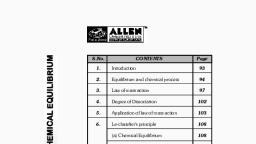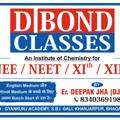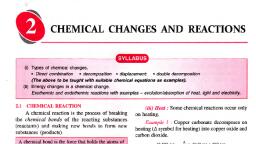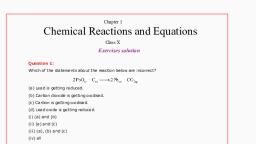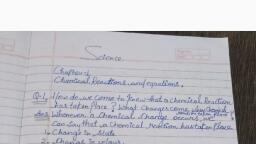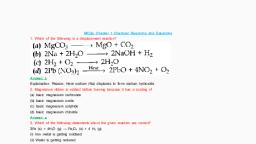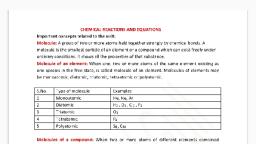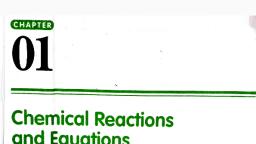Page 1 :
1, , CHAPTER, , Chemical Reactions, and Equations, Multiple Choice Questions, 1. Which of the following is not a physical change?, (a), (b), (c), (d), , Boiling of water to give water vapour, Melting of ice to give water, Dissolution of salt in water, Combustion of Liquefied Petroleum Gas (LPG), , 2. The following reaction is an example of a, 4NH3(g) + 5O2(g) → 4NO(g) + 6H2O(g), (i) displacement reaction, (ii) combination reaction, (iii) redox reaction, (iv) neutralisation reaction, (a) (i) and (iv), (c) (i) and (iii), , (b) (ii) and (iii), (d) (iii) and (iv), , 3. Which of the following statements about the given reaction are correct?, 3Fe(s) + 4H2O(g) → Fe3O4(s) + 4H2(g), (i) Iron metal is getting oxidised, (ii) Water is getting reduced, (iii) Water is acting as reducing agent, (iv) Water is acting as oxidising agent, (a) (i), (ii) and (iii), (c) (i), (ii) and (iv), , (b) (iii) and (iv), (d) (ii) and (iv), , 4. Which of the following are exothermic processes?, (i), (ii), (iii), (iv), , Reaction of water with quick lime, Dilution of an acid, Evaporation of water, Sublimation of camphor (crystals), , (a) (i) and (ii), (c) (i) and (iv), , (b) (ii) and (iii), (d) (iii) and (iv), , 07/05/2018
Page 2 :
5. Three beakers labelled as A, B and C each containing 25 mL, of water were taken. A small amount of NaOH, anhydrous, CuSO 4 and NaCl were added to the beakers A, B and C, respectively. It was observed that there was an increase in, the temperature of the solutions contained in beakers A and, B, whereas in case of beaker C, the temperature of the, solution falls. Which one of the following statement(s) is(are), correct?, (i), (ii), (iii), (iv), , In, In, In, In, , beakers A and B, exothermic process has occurred., beakers A and B, endothermic process has occurred., beaker C exothermic process has occurred., beaker C endothermic process has occurred., , (a) (i) only, (c) (i) and (iv), , (b) (ii) only, (d) (ii) and (iii), , 6. A dilute ferrous sulphate solution was gradually added to the, beaker containing acidified permanganate solution. The light, purple colour of the solution fades and finally disappears., Which of the following is the correct explanation for the, observation?, (a) KMnO4 is an oxidising agent, it oxidises FeSO4, (b) FeSO4 acts as an oxidising agent and oxidises KMnO4, (c) The colour disappears due to dilution; no reaction is involved, (d) KMnO4 is an unstable compound and decomposes in presence, of FeSO4 to a colourless compound., 7. Which among the following is(are) double displacement, reaction(s)?, (i), (ii), (iii), (iv), , Pb + CuCl2 → PbCl2 + Cu, Na2SO4 + BaCl2 → BaSO4 + 2NaCl, C + O2 → CO2, CH4 + 2O2 → CO2 + 2H2O, , (a) (i) and (iv), (c) (i) and (ii), , (b) (ii) only, (d) (iii) and (iv), , 8. Which among the following statement(s) is(are) true? Exposure of, silver chloride to sunlight for a long duration turns grey due to, (i), (ii), (iii), (iv), , the formation of silver by decomposition of silver chloride, sublimation of silver chloride, decomposition of chlorine gas from silver chloride, oxidation of silver chloride, , (a) (i) only, (c) (ii) and (iii), , 2, , (b) (i) and (iii), (d) (iv) only, , E XEMPLAR P ROBLEMS – SCIENCE, , 07/05/2018
Page 3 :
9. Solid calcium oxide reacts vigorously with water to form calcium, hydroxide accompanied by liberation of heat. This process is, called slaking of lime. Calcium hydroxide dissolves in water to, form its solution called lime water. Which among the following is, (are) true about slaking of lime and the solution formed?, (i), (ii), (iii), (iv), (a), (c), , It is an endothermic reaction, It is an exothermic reaction, The pH of the resulting solution will be more than seven, The pH of the resulting solution will be less than seven, (i) and (ii), (b) (ii) and (iii), (i) and (iv), (d) (iii) and (iv), , 10. Barium chloride on reacting with ammonium sulphate forms, barium sulphate and ammonium chloride. Which of the following, correctly represents the type of the reaction involved?, (i), (ii), (iii), (iv), (a), (c), , Displacement reaction, Precipitation reaction, Combination reaction, Double displacement reaction, (i) only, (b) (ii) only, (iv) only, (d) (ii) and (iv), , 11. Electrolysis of water is a decomposition reaction. The mole ratio of, hydrogen and oxygen gases liberated during electrolysis of water is, (a), (b), (c), (d), , 1:1, 2:1, 4:1, 1:2, , 12. Which of the following is(are) an endothermic process(es)?, (i), (ii), (iii), (iv), (a), (c), , Dilution of sulphuric acid, Sublimation of dry ice, Condensation of water vapours, Evaporation of water, (i) and (iii), (b) (ii) only, (iii) only, (d) (ii) and (iv), , 13. In the double displacement reaction between aqueous potassium, iodide and aqueous lead nitrate, a yellow precipitate of lead iodide, is formed. While performing the activity if lead nitrate is not, available, which of the following can be used in place of lead, nitrate?, (a), (b), (c), (d), , Lead sulphate (insoluble), Lead acetate, Ammonium nitrate, Potassium sulphate, , CHEMICAL REACTIONS, , AND, , EQUATIONS, , 3, , 07/05/2018
Page 4 :
14. Which of the following gases can be used for storage of fresh, sample of an oil for a long time?, (a), (b), (c), (d), , Carbon dioxide or oxygen, Nitrogen or oxygen, Carbon dioxide or helium, Helium or nitrogen, , 15. The following reaction is used for the preparation of oxygen gas, in the laboratory, , Heat, → 2KCl (s) + 3O2 (g), 2KClO3 (s) , Catalyst, Which of the following statement(s) is(are) correct about the, reaction?, (a) It is a decomposition reaction and endothermic in nature, (b) It is a combination reaction, (c) It is a decomposition reaction and accompanied by release of, heat, (d) It is a photochemical decomposition reaction and exothermic, in nature, 16. Which one of the following processes involve chemical reactions?, (a), (b), (c), (d), , Storing of oxygen gas under pressure in a gas cylinder, Liquefaction of air, Keeping petrol in a china dish in the open, Heating copper wire in presence of air at high temperature, , 17. In which of the following chemical equations, the abbreviations, represent the correct states of the reactants and products involved, at reaction temperature?, (a) 2H2(l) + O2(l) → 2H2O(g), (b) 2H2(g) + O2(l) → 2H2O(l), (c) 2H2(g) + O2(g) → 2H2O(l), (d) 2H2(g) + O2(g) → 2H2O(g), 18. Which of the following are combination reactions?, , Heat → 2KCl + 3O, (i) 2KClO3 , 2, (ii) MgO + H2O → Mg(OH)2, (iii) 4Al + 3O2 → 2Al2 O3, (iv) Zn + FeSO4 → ZnSO4 + Fe, (a) (i) and (iii), (c) (ii) and (iv), , 4, , (b) (iii) and (iv), (d) (ii) and (iii), , E XEMPLAR P ROBLEMS – SCIENCE, , 07/05/2018
Page 5 :
Short Answer Questions, 19. Write the balanced chemical equations for the following reactions, and identify the type of reaction in each case., (a) Nitrogen gas is treated with hydrogen gas in the presence of a, catalyst at 773K to form ammonia gas., (b) Sodium hydroxide solution is treated with acetic acid to form, sodium acetate and water., (c) Ethanol is warmed with ethanoic acid to form ethyl acetate in, the presence of concentrated H2SO4 ., (d) Ethene is burnt in the presence of oxygen to form carbon, dioxide, water and releases heat and light., 20. Write the balanced chemical equations for the following reactions, and identify the type of reaction in each case., (a) Thermit reaction, iron (III) oxide reacts with aluminium and, gives molten iron and aluminium oxide., (b) Magnesium ribbon is burnt in an atmosphere of nitrogen gas, to form solid magnesium nitride., (c) Chlorine gas is passed in an aqueous potassium iodide, solution to form potassium chloride solution and solid iodine., (d) Ethanol is burnt in air to form carbon dioxide, water and, releases heat., 21. Complete the missing components/variables given as x and y in, the following reactions, (a) Pb(NO3)2 (aq) + 2KI(aq) → PbI2 (x) + 2KNO3(y), (b) Cu(s) + 2Ag NO3(aq) → Cu(NO3)2(aq) + x(s), (c) Zn(s) + H2SO4(aq) → ZnSO4(x) + H2(y), , x → CaO(s) + CO (g), (d) CaCO3(s) , 2, 22. Which among the following changes are exother mic or, endothermic in nature?, (a) Decomposition of ferrous sulphate, (b) Dilution of sulphuric acid, (c) Dissolution of sodium hydroxide in water, (d) Dissolution of ammonium chloride in water, 23. Identify the reducing agent in the following reactions, (a) 4NH3 + 5O2 → 4NO + 6H2O, (b) H2O + F2 → HF + HOF, (c) Fe2O3 + 3CO → 2Fe + 3CO2, (d) 2H2 + O2 → 2H2O, CHEMICAL REACTIONS, , AND, , EQUATIONS, , 5, , 07/05/2018
Page 6 :
24. Identify the oxidising agent (oxidant) in the following reactions, (a) Pb3O4 + 8HCl → 3PbCl2 + Cl2 + 4H2O, (b) 2Mg + O2 → 2MgO, (c) CuSO4 + Zn → Cu + ZnSO4, (d) V2O5 + 5Ca → 2V + 5CaO, (e) 3Fe + 4H2O → Fe3O4 + 4H2, (f) CuO + H2 → Cu + H2O, 25. Write the balanced chemical equations for the following reactions, (a) Sodium carbonate on reaction with hydrochloric acid in equal, molar concentrations gives sodium chloride and sodium, hydrogencarbonate., (b) Sodium hydrogencarbonate on reaction with hydrochloric acid, gives sodium chloride, water and liberates carbon dioxide., (c) Copper sulphate on treatment with potassium iodide, precipitates cuprous iodide (Cu2 I2), liberates iodine gas and, also forms potassium sulphate., 26. A solution of potassium chloride when mixed with silver nitrate, solution, an insoluble white substance is formed. Write the chemical, reaction involved and also mention the type of the chemical reaction?, 27. Ferrous sulphate decomposes with the evolution of a gas having, a characteristic odour of burning sulphur. Write the chemical, reaction involved and identify the type of reaction., 28. Why do fire flies glow at night?, 29. Grapes hanging on the plant do not ferment but after being, plucked from the plant can be fermented. Under what conditions, do these grapes ferment? Is it a chemical or a physical change?, 30. Which among the following are physical or chemical changes?, (a) Evaporation of petrol, (b) Burning of Liquefied Petroleum Gas (LPG), (c) Heating of an iron rod to red hot., (d) Curdling of milk, (e) Sublimation of solid ammonium chloride, 31. During the reaction of some metals with dilute hydrochloric acid,, following observations were made., (a) Silver metal does not show any change, (b) The temperature of the reaction mixture rises when aluminium, (Al) is added., (c) The reaction of sodium metal is found to be highly explosive, (d) Some bubbles of a gas are seen when lead (Pb) is reacted with, the acid., Explain these observations giving suitable reasons., 6, , E XEMPLAR P ROBLEMS – SCIENCE, , 07/05/2018
Page 7 :
32. A substance X, which is an oxide of a group 2 element, is used, intensively in the cement industry. This element is present in bones, also. On treatment with water it forms a solution which turns red, litmus blue. Identify X and also write the chemical reactions involved., 33. Write a balanced chemical equation for each of the following, reactions and also classify them., (a) Lead acetate solution is treated with dilute hydrochloric acid, to form lead chloride and acetic acid solution., (b) A piece of sodium metal is added to absolute ethanol to form, sodium ethoxide and hydrogen gas., (c) Iron (III) oxide on heating with carbon monoxide gas reacts, to form solid iron and liberates carbon dioxide gas., (d) Hydrogen sulphide gas reacts with oxygen gas to form solid, sulphur and liquid water., 34. Why do we store silver chloride in dark coloured bottles?, 35. Balance the following chemical equations and identify the type of, chemical reaction., (a) Mg(s) + Cl2(g) → MgCl2(s), , Heat → Hg(l) + O (g), (b) HgO(s) , 2, Fuse → Na2S(s), (c) Na(s) + S(s) , (d) TiCl4(l) + Mg(s) → Ti(s) + MgCl2(s), (e) CaO(s) + SiO2(s) → CaSiO3(s), , U V → H O(l) + O (g), (f) H2O2(l) , 2, 2, 36. A magnesium ribbon is burnt in oxygen to give a white compound, X accompanied by emission of light. If the burning ribbon is now, placed in an atmosphere of nitrogen, it continues to burn and, forms a compound Y., (a) Write the chemical formulae of X and Y., (b) Write a balanced chemical equation, when X is dissolved in, water., 37. Zinc liberates hydrogen gas when reacted with dilute hydrochloric, acid, whereas copper does not. Explain why?, 38. A silver article generally turns black when kept in the open for a few, days. The article when rubbed with toothpaste again starts shining., (a) Why do silver articles turn black when kept in the open for a, few days? Name the phenomenon involved., (b) Name the black substance formed and give its chemical, formula., , CHEMICAL REACTIONS, , AND, , EQUATIONS, , 7, , 07/05/2018
Page 8 :
Long Answer Questions, 39. On heating blue coloured powder of copper (II) nitrate in a boiling, tube, copper oxide (black), oxygen gas and a brown gas X is formed, (a), (b), (c), (d), , Write a balanced chemical equation of the reaction., Identity the brown gas X evolved., Identity the type of reaction., What could be the pH range of aqueous solution of the gas X?, , 40. Give the characteristic tests for the following gases, (a), (b), (c), (d), , CO2, SO2, O2, H2, , 41. What happens when a piece of, (a) zinc metal is added to copper sulphate solution?, (b) aluminium metal is added to dilute hydrochloric acid?, (c) silver metal is added to copper sulphate solution?, Also, write the balanced chemical equation if the reaction, occurs, 42. What happens when zinc granules are treated with dilute solution, of H2SO4, HCl, HNO3, NaCl and NaOH, also write the chemical, equations if reaction occurs., 43. On adding a drop of barium chloride solution to an aqueous, solution of sodium sulphite, white precipitate is obtained., (a) Write a balanced chemical equation of the reaction involved, (b) What other name can be given to this precipitation reaction?, (c) On adding dilute hydrochloric acid to the reaction mixture,, white precipitate disappears. Why?, 44. You are provided with two containers made up of copper and, aluminium. You are also provided with solutions of dilute HCl,, dilute HNO3, ZnCl2 and H2O. In which of the above containers, these solutions can be kept?, , 8, , E XEMPLAR P ROBLEMS – SCIENCE, , 07/05/2018

